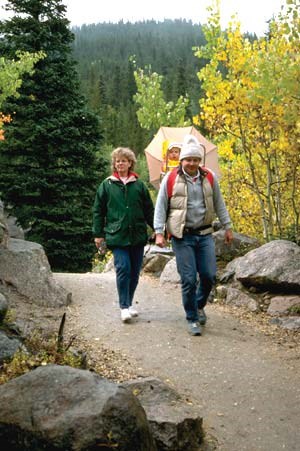Last updated: November 8, 2022
Article
Backcountry Users: Who? Why? What?

The Question: Who is using the backcountry in Rocky Mountain National Park? Why are they here and what do they want?
Having completed a Backcountry/Wilderness Management Plan in 2001, managers at Rocky Mountain National Park realized the need for better information about the people using backcountry and wilderness areas. Specifically park managers wanted to know more about the visitors themselves, why they were in the backcountry, what their needs were, and what they know about wilderness management. Having this information would facilitate management decisions that better serve the park and its visitors.
The Project: Distribute 1,000 surveys to people as they leave the backcountry and statistically analyze the data.
Between July and September of 2002, George Wallace, Jeffrey Brooks, and Matthew Bates of Colorado State University supervised the distribution of 1,000 surveys to people at trailheads and at the Backcountry Office. Usable surveys returned amounted to 682. The social scientists compiled and statistically analyzed the answers on the surveys.
The Results: The average backcountry user is a 43 year-old who lives on the Front Range and hikes 9 miles in 7.8 hours without knowing what designated wilderness is.
The average backcountry user is 43 years old. Sixty-seven percent of backcountry users have an annual household income of between $50,000 and $100,000, and ninety-four percent live in Colorado’s Front Range. Forty-three percent of people surveyed have been in the backcountry at Rocky more than six times while nine percent were on their first backcountry trip. Twenty-four percent of people surveyed were staying overnight in the backcountry for an average of 1.9 nights and hiking an average of 18 miles. The other seventy-six percent were day-hikers walking an average of nine miles in 7.8 hours. The top reasons for going into the backcountry were the enjoyment of the backcountry itself, to pursue a specific activity, to be with friends or family and to be alone.
Forty-one percent of people surveyed encountered park employees in the backcountry, and eighty-five percent of those encounters were positive. Twentyfive percent of people reported seeing too many people during their trip. Negative behaviors witnessed by staff and visitors included littering, inappropriate disposal of toilet paper, harassment of wildlife, graffiti writing, development of social trails, use of cell phones, pagers, radios, and collection of plants or other specimens. Seventy-two percent saw additional wilderness designation as moderate to extreme in importance, but most people lacked an accurate understanding of what wilderness designation is and what the ramifications would be.
This summary is based on published, peer-reviewed and/or unpublished reports available at the time of writing. It is not intended as a statement of park policy or as a definitive account of research results.
For more information on the park’s research program, see www.nps.gov/romo Updated: January 2008 Photo credit: NPS-RMNP George Wallace, Jeffrey J. Brooks, Matthew L. Bates. 2004. A Survey of Day and Overnight Backcountry/Wilderness Visitors in Rocky Mountain National Park. Colorado State University.
